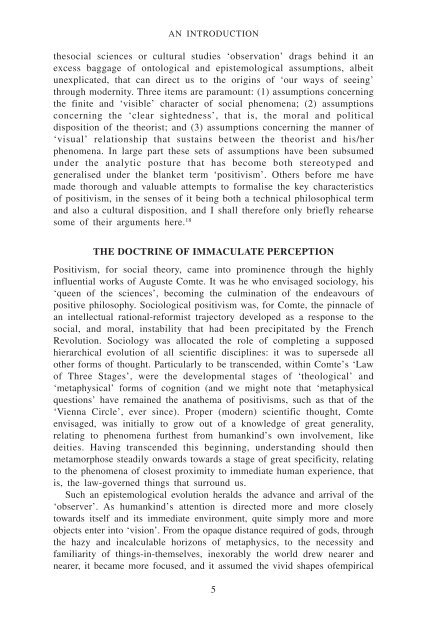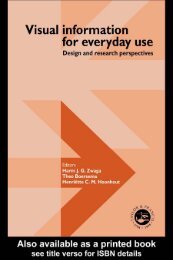Edited by Chris Jenks - carlosmoreno.info
Edited by Chris Jenks - carlosmoreno.info
Edited by Chris Jenks - carlosmoreno.info
Create successful ePaper yourself
Turn your PDF publications into a flip-book with our unique Google optimized e-Paper software.
AN INTRODUCTION<br />
thesocial sciences or cultural studies ‘observation’ drags behind it an<br />
excess baggage of ontological and epistemological assumptions, albeit<br />
unexplicated, that can direct us to the origins of ‘our ways of seeing’<br />
through modernity. Three items are paramount: (1) assumptions concerning<br />
the finite and ‘visible’ character of social phenomena; (2) assumptions<br />
concerning the ‘clear sightedness’, that is, the moral and political<br />
disposition of the theorist; and (3) assumptions concerning the manner of<br />
‘visual’ relationship that sustains between the theorist and his/her<br />
phenomena. In large part these sets of assumptions have been subsumed<br />
under the analytic posture that has become both stereotyped and<br />
generalised under the blanket term ‘positivism’. Others before me have<br />
made thorough and valuable attempts to formalise the key characteristics<br />
of positivism, in the senses of it being both a technical philosophical term<br />
and also a cultural disposition, and I shall therefore only briefly rehearse<br />
some of their arguments here. 18<br />
THE DOCTRINE OF IMMACULATE PERCEPTION<br />
Positivism, for social theory, came into prominence through the highly<br />
influential works of Auguste Comte. It was he who envisaged sociology, his<br />
‘queen of the sciences’, becoming the culmination of the endeavours of<br />
positive philosophy. Sociological positivism was, for Comte, the pinnacle of<br />
an intellectual rational-reformist trajectory developed as a response to the<br />
social, and moral, instability that had been precipitated <strong>by</strong> the French<br />
Revolution. Sociology was allocated the role of completing a supposed<br />
hierarchical evolution of all scientific disciplines: it was to supersede all<br />
other forms of thought. Particularly to be transcended, within Comte’s ‘Law<br />
of Three Stages’, were the developmental stages of ‘theological’ and<br />
‘metaphysical’ forms of cognition (and we might note that ‘metaphysical<br />
questions’ have remained the anathema of positivisms, such as that of the<br />
‘Vienna Circle’, ever since). Proper (modern) scientific thought, Comte<br />
envisaged, was initially to grow out of a knowledge of great generality,<br />
relating to phenomena furthest from humankind’s own involvement, like<br />
deities. Having transcended this beginning, understanding should then<br />
metamorphose steadily onwards towards a stage of great specificity, relating<br />
to the phenomena of closest proximity to immediate human experience, that<br />
is, the law-governed things that surround us.<br />
Such an epistemological evolution heralds the advance and arrival of the<br />
‘observer’. As humankind’s attention is directed more and more closely<br />
towards itself and its immediate environment, quite simply more and more<br />
objects enter into ‘vision’. From the opaque distance required of gods, through<br />
the hazy and incalculable horizons of metaphysics, to the necessity and<br />
familiarity of things-in-themselves, inexorably the world drew nearer and<br />
nearer, it became more focused, and it assumed the vivid shapes ofempirical<br />
5






